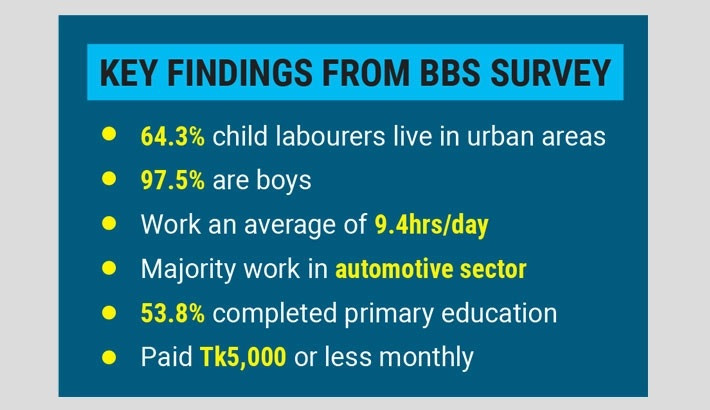‘38,008 children work in five hazardous sectors in country’
Daily Sun Report, Dhaka
Published: 15 Mar 2024

Over 38,000 children aged 5-17 in the country are employed in just five high-risk sectors, with 97.5% of the workforce being boys, according to a survey of Bangladesh Bureau of Statistics (BBS) revealed on Thursday
The survey also finds that most of the child labourers are employed in automobile workshops.
The government has officially recognised 43 sectors as hazardous, but the BBS, after consultation with stakeholders, chose to focus on five key sectors for the survey titled “Establishment Based Sector Wise Working Children Survey 2023”.
The BBS conducted the study in collaboration with the International Labor Organisation (ILO), with an emphasis on sectors identified by the government as high-risk.
Of the total number of child labourers surveyed, the majority work in the automobile sector, with 35.7% living in rural areas and 64.3% in urban areas.
According to the survey, 898 child labourers are employed in fish drying, while 5,281 are employed in footwear production, 4,099 in welding or gas torch mechanics, 24,923 in automotive workshops and 2,805 in informal and local tailoring or clothing sector.
The survey also highlighted the types of hazardous work carried out by child workers, with a focus on heavy loads, pulling goods and working at heights.
Around 19.1% of boys and 7.7% of girls are involved in carrying, pushing or pulling heavy loads. Tasks that require climbing high off the floor/ground involve approximately 8.1% of boys and only 0.3% of girls.
In terms of using only sharp objects, a higher proportion of boys engaged in this activity. It also shows that some children are exposed to conditions involving fire, hot machinery or dangerous electrical equipment (20.2%), while others work in environments where dust, sand, smoke or fumes can hinder their breathing and visibility (31.1%).
Some children work extended hours directly under the sun without breaks (14.8%), and a smaller percentage are exposed to pesticides and other chemicals (3.9%).
Children, who are engaged in these five sectors, work an average of 9.4 hours per day. More than half of companies do not follow safety regulations.
Less than half of working children receive free food from establishments. A significant proportion of children working in these sectors have both parents, with 96.7% of them living together, reflecting the prevailing social norms in the country.
Among these children, a majority (53.8%) have typically completed only primary education, while 11.7% have completed SSC education.
Furthermore, the study findings indicate that parents of working children also have limited educational backgrounds, indicating that a significant portion of child laborers come from communities with lower levels of education.
In rural areas, children working in these five sectors are mainly recruited by their relatives or parents, and their living conditions are characterised by very low levels of housing.
Findings have also brought to light that 51.4% of companies in the selected hazardous sectors pay child laborers a monthly wage of Tk5,000 or less, while 28.7% of these companies offer wages of Tk10,000 or less and only 1.4% higher salaries.
Importantly, many of these children working in these establishments have the flexibility to leave their jobs if they choose without significant barriers.
However, a significant majority of these working children enjoy weekends off (88.4%) and get holidays during festivals.

